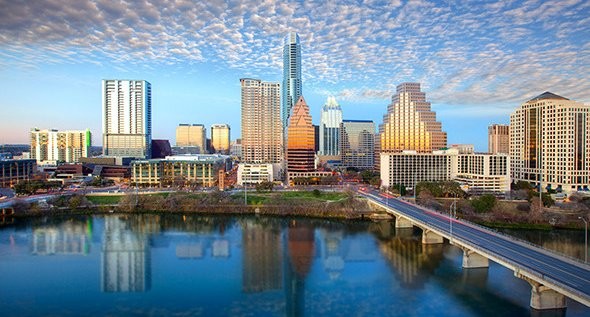
Austin rated #1 for real estate investment opportunities
Every year PwC, together with the Urban Land Institute, determines how the real estate industry views upcoming trends and opportunities. Since I’m based in PwC’s Austin, Texas, headquarters, I was intrigued by how our report, Emerging Trends in Real Estate 2017, assessed my home town.
Austin, in fact, has been named by the PwC and ULI study as the “Best City” in the U.S. for real estate investment and development opportunities.
Everyone knows Texas’ state capital is a happening place. Hey, it’s got that funky music scene, and burgeoning high-tech and pharma businesses. And Austin already has been named to various “best” lists (places to live[1], greenest[2], places to retire[3], etc.). Now, according to PwC’s 38th annual Emerging Trends report, Austin is singled out as tops for its overall appeal to real estate investors.
Drawn from studies, analyses and the views of nearly 2,000 industry participants in the U.S. and Canada, the city’s fast growth, neighborhoods with high quality of life, and economic diversity have caught the fancy of the industry. In short, Austin is a place where people like—even love—to live and work, and as a result where the real estate industry is finding strong opportunities.
So, what is it about Austin that’s so appealing to real estate investors? Let’s delve a little further into Emerging Trends in Real Estate 2017.
Essentials are driving appreciation of Austin
Overall, the industry voiced a strong appreciation of Austin’s “authentic, niche neighborhoods,” and its depth of economic diversity that ranges from manufacturing and education to health care and technology. Here, investment opportunities in multi-purpose commercial space is increasingly featuring different types of tenants using new types of spaces for different uses at different times of the day.
But, while these are important factors driving Austin to the top of Emerging Trends’ top investment markets, one undeniable ingredient is the market’s “hip” factor, making Austin attractive to a millennial-dominated workforce.
Numbers tell the tale: The proportion of millennials in Austin is an eye-popping 35 percent of the entire population, compared to 30 percent of the U.S. as a whole comprised of those between the age of 18 and 34. Moreover, the area’s millennial population is growing seven times faster than the nation overall.
More than just a youth movement, these people are the ones with STEM skills—science, technology, engineering and mathematics—and are vastly appreciated by today’s labor market. Austin, already a university town, is attracting an abundance of millennials, which in turn is driving real estate investment opportunities.
At its most basic, this year’s Emerging Trends report demonstrates how real estate investment opportunities arise—and are perhaps dependent on—where, how and when people like to work. In this sense, Austin is a poster child for attractive metro areas everywhere.
Other factors comprising the whole
Emerging Trends examined more than just overall investment attractiveness. The report breaks out investment opportunities by market in homebuilding, industrial properties, office development, retail, hotel investments and more, and examines these by regions of the country.
So, how does Austin do in these various categories? It varies.
In homebuilding prospects, Austin ranks 11th behind No. 1 Raleigh/Durham and many other metro areas, and—for buy/hold/sell recommendations—only 20th in industrial properties, 13th for office properties and 14th in hotel properties.
But the Austin market has had a phenomenal 43 percent in-migration rate in recent years—no other market comes close, except Las Vegas—and a strong growth in disposable income. Austin isn’t always at the top of the scale in every investment category, but it’s a contender in most. That’s why it’s No. 1 in the report’s 2017 forecast.
The characteristics that have driven Austin to the top of Emerging Trends’ markets to watch also brighten prospects elsewhere. Columbus, Ohio, for example, is enjoying lots of entrepreneurial activity, Richmond has a similar “hip” factor, Pittsburgh combines solid traditionalism with lots of high-tech startups, and Charleston is growing strongly with an emphasis on tech, manufacturing and transportation.
As always, there are caveats for investors. In any rapidly growing market there is concern about transportation, and Austin is experiencing growing pains here. Also, according to Emerging Trends, the market’s cost of living and of doing business has been on the rise, and investors are watching this carefully.
To be sure, in this year’s survey—whether it’s No. 1 Austin or No. 78 Buffalo—it’s important to consider an investor’s strategy, risk tolerance, return requirements and access to deals. Given this, you may be surprised at what other markets do best in each specialty and region. Check out Emerging Trends in Real Estate 2017, downloadable for free.
[1] "10 Best Big Cities". Money Magazine (CNN).
[2] "The 10 Greenest Cities in America" (City Guide, MSN).
[3] "The 10 Best Places to Retire" (Yahoo Finance).
MBA Candidate at Chicago Booth
7yYou are welcome Yuneisy, I really enjoyed my semester at UT Austin and I think it is a great city for students and young professionals.
Consolidations Acct. Supervisor @ Granite Construction | President of “SOMOS Granite” ERG | Board member at FoodWhat non profit organization
7yI have been in Austin, and I love it. Definitely a place I will consider in my future. Thanks for the information.
Global Sustainability Reporting I Digital Accelerator I PricewaterhouseCoopers International
7yJason C. - sounds interesting